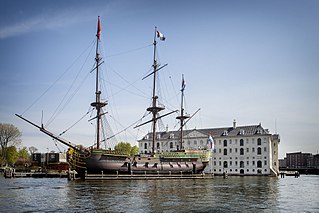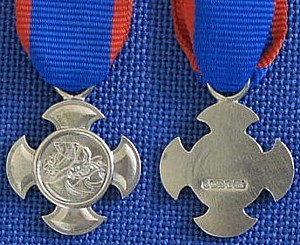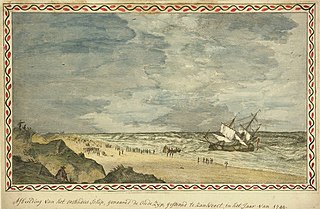
Batavia ( ) was a ship of the Dutch East India Company (VOC). She was built in Amsterdam in 1628 as the flagship of one of the three annual fleets of company ships and sailed that year on her maiden voyage for Batavia, capital of the Dutch East Indies. On 4 June 1629, Batavia was wrecked on the Houtman Abrolhos, a chain of small islands off the western coast of Australia.

The Amsterdam was an 18th-century cargo ship of the Dutch East India Company. The VOC was established in 1602. The ship started its maiden voyage from Texel to Batavia on 8 January 1749, but was wrecked in a storm on the English Channel on 26 January 1749. The shipwreck was discovered in 1969 in the bay of Bulverhythe, near Hastings on the English south coast, and is sometimes visible during low tides. The location in 1969 was found by Bill Young, the site agent/project manager for the sewage outfall being built by the William Press Group. With time on his hands during the long stay away from home, he followed up the rumour of the going aground. He was castigated by the Museum of London for scooping out the interior of the bow with a digger as it could have led to the structure collapsing. However, it uncovered the initial items which led to a more extensive excavation of the cargo which reflected life at the time. The wreck is a Protected Wreck managed by Historic England. Some of the findings from the site are in The Shipwreck Museum in Hastings. A replica of the ship is on display in Amsterdam.

Wolraad Woltemade was a Cape Dutch dairy farmer, who died while rescuing sailors from the wreck of the ship De Jonge Thomas in Table Bay on 1 June 1773. The story was reported by the Swedish naturalist Carl Peter Thunberg who was in South Africa as a surgeon for the Vereenigde Oostindische Compagnie at the time.
Tryall was a British East India Company-owned East Indiaman launched in 1621. She was under the command of John Brooke when she was wrecked on the Tryal Rocks off the north-west coast of Western Australia in 1622. Her crew were the first Englishmen to sight or land on Australia. The wreck is Australia's oldest known shipwreck.

Baron Joachim Ammena van Plettenberg was the governor of the Cape of Good Hope from 11 August 1771 to 14 February 1785. Plettenberg was presiding governor after Ryk Tulbagh's death. On 18 May 1774 he was permanently appointed as governor.

The Woltemade Decoration for Bravery, Silver is the lesser of two classes of a South African civil decoration for acts of bravery. It replaced the King's Medal for Bravery, Silver and Queen's Medal for Bravery, Silver, the award of which was discontinued in South Africa in 1961.

't Vliegent Hart, also sometimes listed as 't Vliegent Hert, was an 18th-century East Indiaman or "mirror return ship" of the Dutch East India Company. 't Vliegend Hart was built in 1729 in Middelburg for the Chamber of Zeeland. Her maiden voyage was in December 1730, departing from Fort Rammekens (Netherlands) to Batavia, commanded by captain Abraham van der Hart.

The Woltemade Decoration for Bravery, Gold is the senior of two classes of a South African civil decoration for acts of bravery. It replaced the Union of South Africa King's Medal for Bravery, Gold and Union of South Africa Queen's Medal for Bravery, Gold, the award of which had been discontinued in 1952 and 1961 respectively.

The Woltemade Cross for Bravery, Gold, post-nominal letters WD, is the senior of two classes of a South African civil decoration for acts of bravery. It replaced the Union of South Africa King's Medal for Bravery, Gold, Union of South Africa Queen's Medal for Bravery, Gold and Woltemade Decoration for Bravery, Gold, all of which ranked on par with each other and the award of which had been discontinued in 1952, 1961 and 1988 respectively.

The Woltemade Cross for Bravery, Silver, post-nominal letters WDS, is the lesser of two classes of a South African civil decoration for acts of bravery. It replaced the Union of South Africa King's Medal for Bravery, Silver, Union of South Africa Queen's Medal for Bravery, Silver and Woltemade Decoration for Bravery, Silver, all of which ranked on par with each other and the award of which had been discontinued in 1952, 1961 and 1988 respectively.

Paarden Eiland is a light industrial area of Cape Town, South Africa. It is located on the Table Bay coast about 5 kilometres (3.1 mi) from the city centre.
De Negotie often shortly written as Negotie was a 1784 built ship of the Dutch East India Company.
Anna Catharina was an 18th-century East Indiaman or "mirror return ship" of the Dutch East India Company.
Horstendaal, also written as Horftendaal and Horstendael, was an 18th-century East Indiaman of the Dutch East India Company.
Lelie was a 17th-century East Indiaman galiot of the Dutch East India Company.

Oude Zijpe, also written as Oude Zype, Oude Zijp and Oude Sype was an 18th-century fluyt of the Dutch East India Company.
Midloo, also written as Midlo, was a 18th-century East Indiaman of the Dutch East India Company.














